Professional Bears Certify Equipment As Bearproof

When you go camping, you want to keep your food somewhere bearproof. You want the bears unable to break into your cooler and hopefully to not even be able to smell the goodies within. That’s important for you of course (even if you took the precaution to store the cooler far from where you sleep), because you want that food for yourself. It’s also important for everyone who camps after you. A bear who stumbles on an easy packaged meal once will pursue campers in search of more for the rest of its life.
Manufacturers have a few ways of testing products against bears. In the ’80s, they mostly dropped heavy objects on items to replicate the force a bear exerts. These objects even had spikes, to focus that force in the same way a bear’s teeth does.
A better way, of course, uses actual bears. Not wild bears—we can’t monitor wild bears easily, and like we said just now, a wild bear who successfully breaks into a food cache becomes a problem bear in the future. Instead, we use the bears at the Grizzly and Wolf Discovery Center in West Yellowstone, Montana.
Don't Miss
The Discovery Center is a special sort of sanctuary for bears. They don’t just keep and breed animals there, like so many wildlife preserves for vulnerable animals. They transport problem bears from all over Canada and the American West. When we hear reports of a grizzly that keeps entering town, or just can’t stay away from a golf course, people could shoot it dead, or we can tranq it and call up the Discovery Center, asking them if they have any vacancies.
Companies that make camping coolers and also other containers like dumpsters send their prototypes to the center. Human employees fill the stuff with food like honey (yes, bears love honey, that’s no myth) and peanut butter. Then bear employees set upon them, trying to break in. Sometimes, they succeed, and that’s a happy day for the bear. If the container lasts 60 minutes without the bear breaching it, it passes the test and earns official certification from the Interagency Grizzly Bear Committee. And then someone opens the container and feeds the food to the bear anyway, we like to imagine.
This fact came from the One Cracked Fact newsletter. Want more like this, straight from your email inbox, without any ads or popups? Join here:
For more grizzly facts, check out:
Mud Creek Grizzly vs. Scientists
6 Things You Learn Being Mauled By Bears
Follow Ryan Menezes on Twitter for more stuff no one should see.
Top image: Derek Bruff
